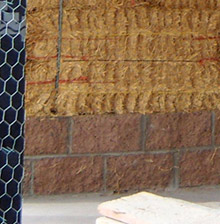Contact Pacific Southwest Waste Program
Pacific Southwest, Region 9
Serving: Arizona, California, Hawaii, Nevada, Pacific Islands, Tribal Nations
Straw Bale Classroom

Straw bale buildings have come a long way since the Three Little Pigs and the Big, Bad Wolf. Students from Moapa Valley High School are green building pioneers and are proving that no wolf will be able to blow down their new straw bale classroom.
The Conservation District of Southern Nevada using a $30,000 Resource Conservation Grant from EPA, designed and built a straw bale classroom. The project was funded to demonstrate green building and stimulate student interest in energy efficient and sustainable structures. The classroom will be used to host a variety of resource conservation workshops for the local and urban communities of Southern Nevada.
The built environment has a vast impact on the natural environment, human health, and the economy. In the United States, buildings account for 39 percent of total energy use, 12 percent of the total water consumption, 68 percent of total electricity consumption and 38 percent of the carbon dioxide emissions. By adopting green building strategies, such as the construction of straw bale buildings, we can maximize both economic and environmental performance.
Structures made out of straw bales have environmental, economic and advantages:
- The thick, straw walls are energy efficient and keep buildings cool in the summer and warm in the winter.
- Straw is a renewable resource and is grown and harvested faster than lumber. It can also be grown locally to cut down on the energy and cost involved in transportation of building materials.
- Straw bales are inexpensive and therefore save on building costs.
- Plaster-coated straw bales are as flame-resistant as conventional homes.
Since 2004, the students at Moapa Valley High, the Conservation District of Southern Nevada, the high school Future Farmers of America (FFA) chapter, and faculty advisors have been working on this project. They procured the straw, designed the classroom, built the classroom, and even planted a native plant demonstration garden in front of the site. Although the students originally planned to grow the straw on site, a generous local donor provided the straw for the building. Signs were also installed throughout the site that explain the significance of the structure and how it helps preserve the environment.
Moapa Valley High School is a school in Clark County with a deep agriculture tradition. In fact, Moapa High is the only high school in Nevada to have a school-owned farm. This includes a full-time farm manager who oversees the 40 acre, fully functioning farm that raises cattle and crops. The produce is sold to local grocery stores and they hope to soon expand into farmers markets. The FFA students are heavily involved in this farm which prepared them for the hard work required to fulfill the task of building the straw bale classroom.
“The Moapa Valley Farm is not only about agriculture and education, it's also about community” states Jennifer Szwejbka of the Conservation District of Southern Nevada. “Building the straw bale structure brings a community together to learn about and build a sustainable structure, and it provides a location for the community to come together. The Moapa community feels passionate about the school farm because of its historical value, educational value, and the potential it has to bring their community together time and time again.”
The hard work of the students, along with many community members, paid off with a beautiful, environmentally friendly structure that was unveiled at a May 27, 2008 grand opening event. In addition to EPA Region 9 funding, the project was also supported by the Clark County Department of Air Quality and many local donors.





